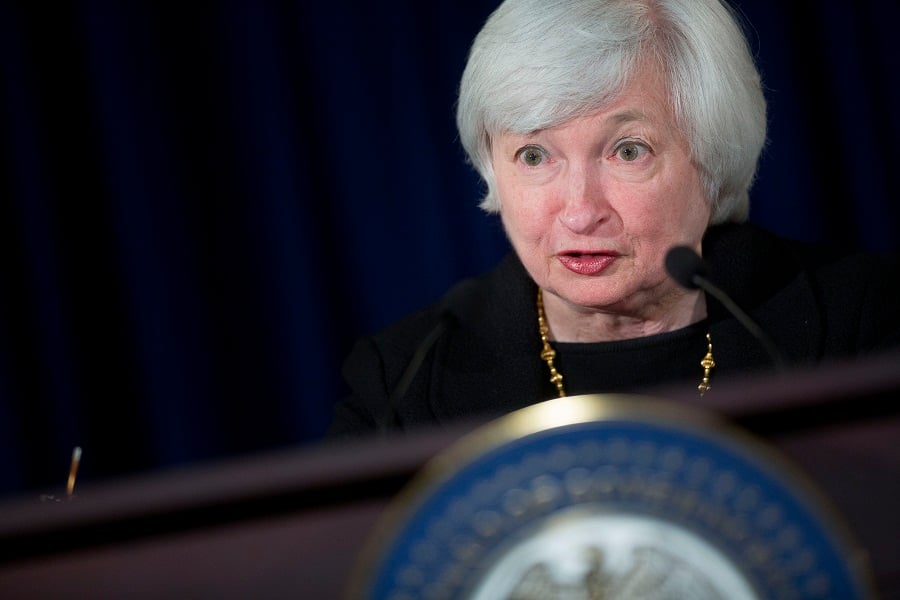Janet Yellen has the fixed-income market just where she wants it: ripe for the first increase in U.S. interest rates since 2006.
Just about every indicator is telling the Federal Reserve Chairwoman a move at next week's policy meeting would cause government bonds little disruption. Her guidance has money markets pricing an extraordinarily slow pace of tightening, volatility metrics show no signs of panic, and forwards indicate benchmark rates will remain contained. Differences between shorter- and longer-term yields are flashing a positive signal for the economy.
A green light from Treasuries is vital to avoid derailing the recovery that Ms. Yellen has nurtured because they help determine borrowing costs for businesses and consumers. Acting decisively now may even lend investors greater confidence in the outlook for growth.
“The debt markets have priced in a lot and it's now time for the Fed to take advantage of that,” said Peter Tchir, head of macro credit strategy in New York at Brean Capital, which has clients ranging from hedge funds and pension funds to money managers specializing in fixed-income markets.
(More: Global inflation could derail Fed's plan to bring rates back to normal)
Benchmark Treasury 10-year note yields were at 2.18% at 9:39 a.m. in New York on Tuesday, versus an average of 3.17% during the past decade. Forward contracts foresee a gradual increase to 2.4% in one year, with yields only reaching 3% around a decade from now. That's a boon for any money manager fretting about an end to the 25-year bull market in bonds.
“The 10-year Treasury is at a very comfortable point, with forwards showing even a Fed hike won't move yields much higher,” Mr. Tchir said. “Once we get through the first increase, and see the economy can do fine, it will remove the looming worry.”
FORWARD GUIDANCE
Bond investors have had plenty of time to get comfortable with the idea that interest rates are going to rise from near zero. As long ago as March, the Fed introduced the possibility of a move in 2015. Policy makers said more recently they intended to act before year-end, assuming continued improvement in the labor market, as they were confident inflation would move back toward their 2% goal.
With the unemployment rate at a seven-year low, futures trades are pricing in a 30% likelihood of an increase this month and 59% odds of a tightening before Dec. 31. The Fed will announce its next policy decision on Sept. 17.
Even when the Fed does move, communication tools such as officials' estimates for the future evolution of interest rates and Ms. Yellen's own press conference may help assuage market nerves.
“It's not only about the move itself, it's also about the statement,” said Christoph Kind, head of asset allocation at Frankfurt Trust, which manages about $20 billion. If “the Fed makes clear that there is a lot of time until the next hike, then there might be some relief and that could be good news.”
CAUTIOUS APPROACH
Money-market derivatives indicate
investors see an exceptionally slow pace of tightening. They show the fed funds rate will average just 0.60% one year from now. Assuming it trades close to the middle of the official band, that doesn't even price in two quarter-point increases.
For the Fed to keep bond traders onside, it may need to persuade them this is an environment closer to the tightening cycle started in 2004 than the one begun in 1994.
(More: LPL and Wells Fargo's bold calls predict as much as 9% return on stocks this year)
Starting with a shift to 1.25% in June 2004, the Fed raised rates by a quarter percentage point 17 times to 5.25% in June 2006. Helped by transparency in Fed decisions, fixed-income securities still managed positive annual returns between 2004 and 2006.
By contrast, the Bank of America Merrill Lynch U.S. Broad Market Index of bonds fell 2.75% in its worst-ever annual loss in 1994 as then-Fed Chairman Alan Greenspan surprised investors by almost doubling the benchmark rate.
The path to higher rates isn't totally free of warning signs this time either. Emerging-market stocks and currencies are tumbling, while a surge in credit spreads and stock-market volatility has pushed Bloomberg's U.S. Financial Conditions Index below zero for the first time in three years, indicating market conditions are becoming restrictive.
“Yes, they want to tighten and the market understands they want to tighten, but they do need to be a bit careful,” said Jeremy Lawson, chief economist in Edinburgh at Standard Life Investments, which manages about $380 billion. “The more important question is not what happens in the first day or the first week, it's what happens over the medium term.”
TIME TO MOVE
For now, Treasuries at least are showing few signs of alarm. An August jump in Bank of America Corp.'s index measuring projected swings failed to take it above this year's high set in February, leaving it more than 12% below the average back through 1988.
And a widening gap since mid-August between yields on five-year Treasuries and those with 30 years to maturity indicates the Fed can move without killing off the potential for inflation to eventually reach the central bank's 2% target.
“Any time the Fed goes into a tightening cycle there are always very valid and very good arguments to not do that,” said Omer Esiner, chief market analyst at currency brokerage Commonwealth Foreign Exchange Inc. in Washington. “If you wait until all signals are telling you to raise interest rates you've already missed the boat and it's already too late.”







